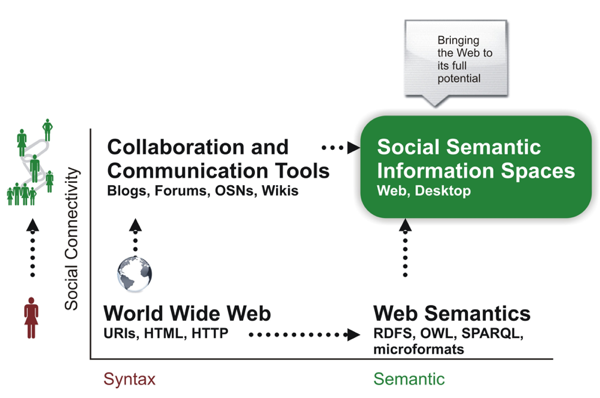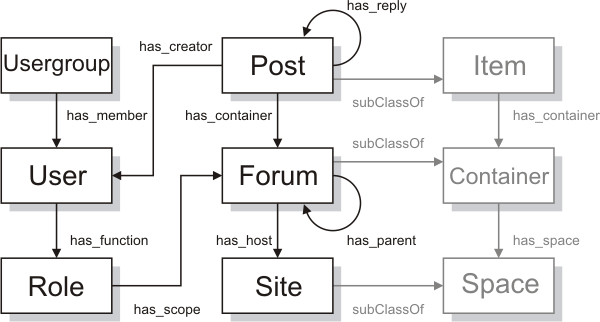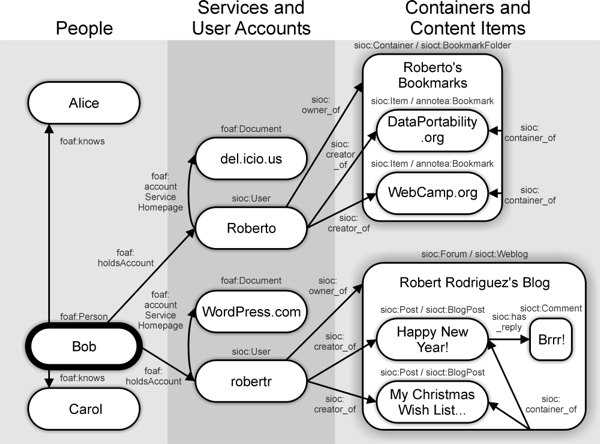
W3C Workshop on the Future of Social Networking, 15-16 January 2009, Barcelona
John G. Breslin 1,2, Uldis Bojārs 1, Alexandre Passant , Sergio Fernández 3, Stefan Decker 1
This paper describes work performed during the last few years in the context of the SIOC project in order to model social data on the Web using Semantic Web technologies. We will give an overview of the SIOC model, describe various applications and use cases that take advantage of it (from domains ranging from mobile phones to life sciences), as well as mention future works regarding the project.
While social media services have introduced new trends and practices regarding how people publish and share data on the Web, their popularity has also led to various issues, such as interoperability of social networks and exchange of social media contributions (SMC) between applications. Due to the heterogenous nature of models for SMC (generally depending on the provider), finding, interlinking and querying such data is a complex issue. On the other hand, Semantic Web technologies provide standards and models to build a Web of Data, with unified models to represent interlinked data from different sources. Hence, our vision is that combining Semantic Web technologies and social media paradigms will lead to "Social Semantic Information Spaces" (Figure 1), where information is socially created and maintained as well as being interlinked and machine-understandable, leading to new ways to discover information on the Web.
Figure 1: Social Semantic Information Spaces

SIOC - Semantically-Interlinked Online Communities [1] - aims to achieve this goal, by providing a complete framework for modeling activities and SMCs in online communities using Semantic Web technologies and standards. Having being accepted as a W3C Member Submission in June 2007, used in tens of applications from Web 2.0 to Life Sciences (more later), and more recently being recommended for use in Yahoo! SearchMonkey-based applications, SIOC has become an inevitable core element of the Social Semantic Web.
In order to achieve this goal of common semantics across various social media services and applications, SIOC relies on a complete food-chain that consists of:
One of the aims when developing the SIOC ontology was to keep it as simple as possible, yet powerful, so that it could be easily deployed in existing applications [3]. Figure 2 describes the main classes of the SIOC core ontology, that can be used to model facts such as "Here is an item written by Alice that has been commented on by Bob at http://example.org/aliceblog" and "Alice is the moderator of http://example.org/aliceboard while Bob is a simple reader", using the same model wherever the data comes from.
Figure 2: The SIOC core ontology model

While the SIOC core ontology provides a sufficient model to describe the activities of online communities, it is not fine-grained enough to allow one to distinguish between, e.g., a blog post and an update on a microblogging service, as it only introduces a single sioc:Post class.
In order to define this additional level of semantics, a SIOC Types module was designed, modeling more than 20 different types of content, such as sioct:MicroblogPost and sioct:WikiArticle.
SIOC reuses the Dublin Core model to define various attributes of created content (such as the creation date of an item, using dcterms:created) and FOAF - Friend Of A Friend - to model personal identity and related attributes.
Interlinking FOAF and SIOC also provides a model for identity federation on the Web.
While one can have different user profiles on different websites (represented as instances of sioc:User), they all relate to the same physical person (foaf:Person).
Thanks to those relationships, all the SMCs of a given physical person can be modeled in a single global graph of RDF data, as Figure 3 shows, enabling a model for interoperability and portability of social data between services.
Figure 3: Modeling social data with SIOC

Various SIOC exporters have been developed for existing applications, such as WordPress, Drupal and vBulletin. Moreover, exporters have also been designed for more generic applications such as mailing lists or IRC logs. While those exporters have been mainly created by members of the SIOC community, SIOC has recently been recommended by other services such as Yahoo! SearchMonkey. Thanks to those efforts, the same queries (using SPARQL) can be used to retrieve information created on a blog on WordPress or on a mailing list.
While the main motivations behind SIOC came from Web 2.0 systems' lack of semantics, SIOC can be efficiently used for social data integration in Enterprise 2.0 environments. For example, in the Ecospace EU Integrated Project, SIOC is used as an exchange mechanism between heterogeneous collaborative working environments (currently between Business Collaborator and BSCW, with work beginning on NetWeaver). As part of the core of technologies involved in the ExpertFinder initiative, SIOC can be used as a semantic mediation layer for social data, that can then be integrated from distributed sources and easily queried and combined thanks to common semantics, as seen on some dedicated corporate use-cases.
Another interesting use case for SIOC is its use in life science applications. Recent efforts in that direction includes the SWANSIOC initiative, that aims to provide models and tools for scientific discussion modeling in the context of neuromedicine.
As part of their data portability drive, the mobile phonebook service ZYB (recently acquired by Vodafone) have announced that their latest release of ZYB allows FOAF and SIOC exports from user's profile pages (by default, a restricted data export is produced, but the full FOAF or SIOC export is available to the users themselves at zyb.com/profilename.foaf and zyb.com/profilename.sioc respectively).
SIOC is being used to describe actions performed by ZYB users such as shouting, writing comments or updating status messages on Facebook.
ZYB have also released a new public feeds API that produces data in RSS, JSON, FOAF, SIOC, vCard and vCalendar.
On a related topic, SIOC is a foundation for SMOB - an open, semantic and distributed microblogging plaform - which can have interesting uses when combined with mobile devices.
Furthermore, we envision other use-cases regarding SIOC and the Semantic Web for mobile devices in another paper of that workshop.
While we have primary worked on modeling SMCs, another aspect of social media is the ability to define online presence, especially with the reach of ubiquitous social networking and services such as Twitter. We are thus currently working on aligning the Online Presence Ontology with SIOC, so that existing SIOC tools can consume OPO-based data. Once again, our goal for interlinking these two vocabularies is to extend interoperability between applications and their data.
Another important aspect of Web 2.0 systems is the use of tagging. SCOT - Semantic Cloud Of Tags - aims to provide a model for tag interoperability, and is based on SIOC. While SIOC aims to provide portability of SMCs, SCOT extends this idea by providing portability of tags and tagged data.
In this position paper, we have given an overview of the SIOC project as a means for exchanging content between semantically-interoperable social spaces, and we have described its application in some use cases of note, including the domains of Web 2.0 and Enterprise 2.0, life sciences and mobile phones. Even when describing the life sciences use case, we see that social data is everywhere. Thus, we expect that SIOC and its principles can be applied and used in many situations and environments, enabling large scale interoperability between services and applications, wherever the data comes from but also independent of whatever device was used to create it. In general, we believe there is great potential for future applications exploiting SIOC, and would propose that this be a focus for any upcoming workgroup or interest group dedicated to Social Network or Social Web interoperability within the W3C.